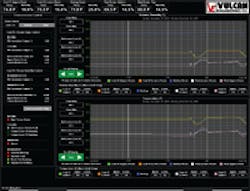RF + Database Optimizes Shell-Management Systems for Investment Casting
Investment casters rely on an increasing range of technologies to make their products better and their operations more productive, and none is more important than the processes for managing casting shells. According to Eddie Blackwell, manager of Robotic Sales for Vulcan Engineering Co., shell-management systems can increase productivity and enhance product tracking for investment casting foundries, and give users the ability to make changes to the manufacturing process to ensure the best quality casting. The key to using shell-management systems successfully, Blackwell explains, is to work with shell room operators and key personnel to determine the desired options that give the foundry the highest quality possible for the finished parts.
Shell management systems make use of radio- frequency (RF) tags and feature a database structure that allows customers to enter and store a wide range of information. This information may include descriptions and names of parts; date of production; the number of shell coats to be applied; the robotic recipes for particular shell types; minimum drying time per shell coat; temperatures of parts during the drying process; and others.
From these criteria, and others, foundries are able to track parts through the manufacturing process, as well as make changes to the process as needed, to develop the best shells possible.
There are three types of shell-management systems, according to Blackwell:
Mold Tracking — These packages incorporate a PLC with RF tags to track parts as they travel through the shell building process, according to pre-determined recipes. This PLC-driven system is the intelligence behind a completely automatic process that needs only minimal human intervention. Once a part is entered into the system it is completely processed through the shell coating system before it has any further contact with the plant personnel. Information, such as the shell part number, environmental conditions, dry times, customer part number and many other items can be tracked through the system. “This is the foundation to build upon adding on database functionality,” Blackwell says.
Shell-Management Database System — This system interfaces with the mold tracking system and allows users to collect data and enter and edit information pertaining to each individual shell. With a few clicks, the operator is able to see the status of any shell, room conditions, and equipment operation at any time throughout the day. In addition to the current production status, a history of each shell that is processed through the system is recorded and available for future analysis.
The most typical information pulled from the archived/stored data includes part number, part description, customer’s name, actual dry time, number of coats applied, robot recipe number and the date and time the shell coat began. Additionally, the SMS can store the temperature and humidity of each part every 15 minutes with the date and time of each reading. The ability to record and store this information makes it very easy for the foundry’s process engineer to evaluate the data and make any process changes or provide them with the information required to easily troubleshoot problems.
Advanced Shell-Management System — This advanced option allows investment casters to monitor the shell room from an external site via an Ethernet connection. Operators can be informed of problems with the drying process at a remote location, and have the ability to troubleshoot and monitor equipment from an off-site location, to make corrections to eliminate problems. Advanced alarm features enable quicker pinpointing of problem areas with the equipment, resulting in less downtime. All the alarming errors are stored in the database for future analysis that can be used to fine-tune preventative maintenance schedules.
Blackwell also notes that these shell-management systems are simple to interface with a corporate IT network for information backup, and provide critical real-time information to the organization.
